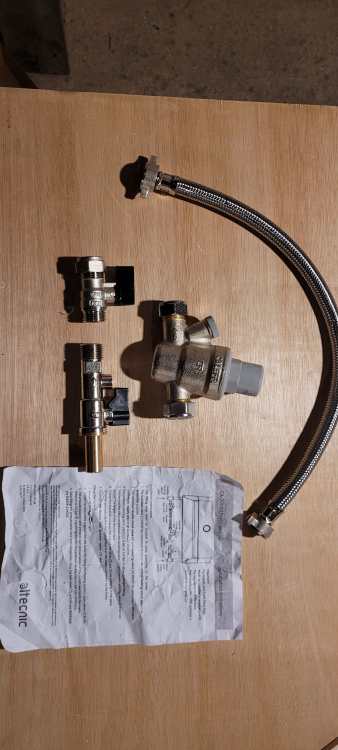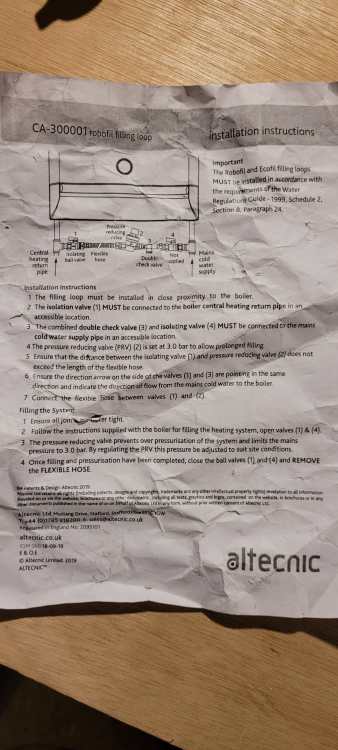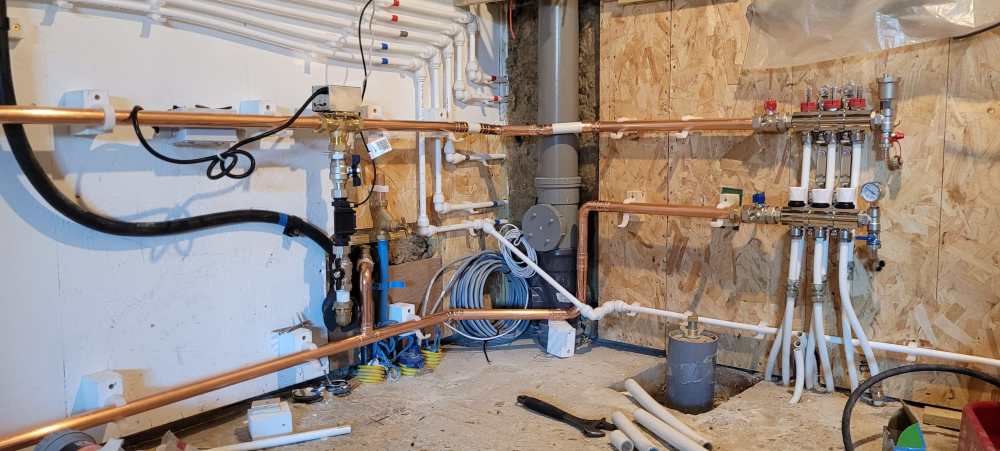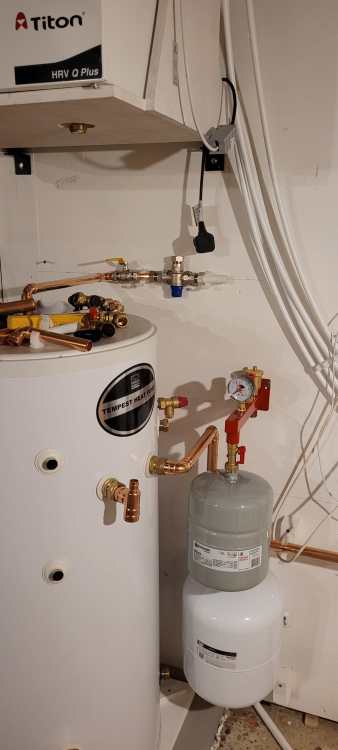-
Posts
5464 -
Joined
-
Last visited
-
Days Won
15
Everything posted by MikeSharp01
-

Hi everyone! Planning a bungalow conversion near Guildford area
MikeSharp01 replied to Bob88's topic in Introduce Yourself
Don't listen to him, nobody uses bulldozers any more! Welcome to THE forum for people like us. -
Welcome @markg123 to THE forum for people like us.
-
Far too small - 4mm is minimum and 6mm prob better for run lengths.
-
We have two Tundishes (Only one un-trapped version in the picture but two new trapped versions have arrived today and will be fitted tomorrow). I have roughly plumbed them to arrive at what I think of as a good layout, see pic. (The plastic is just to get the dimensions right it will all be copper.) I have / would like to join the control group overpressure relief flow and that for the heating circuit overpressure together to one Tundish. It will be easy to workout which is flowing as they are on different circuits and the relief pressures differ significantly. The other Tundish will be exclusive to the Pressure / Temperature relief on the tank. Both then drop in 22mm to 28mm copper and then be routed to the drain in 28mm JG Speedfit plastic pipe. The runs to both Tundishes are less than 600mm the copper and JG pipe are both proof against the max output temperatures. I still need to figure out how to get from 28mm - to something I can connect to the soil pipe. so any thoughts on that gratefully accepted.
-
I was thinking about this on Thursday when I realised that our system volume is only enough when the Underfloor Heating (UFH) is in the loop when its just running through the domestic hot Water (DHW) tank the volume is a lot less. However I also feel that as far as the DHW tank is concerned the heat transfer is roughly reversable, I guess entropy and a few other factors will have a part to play, so the hot water in the tank will give its heat up to the circulating HP circuit and so all will be well. I dimly recall working out that we might need ~0.8kWh for a defrost, if all that comes from the Tank - because the other volume in the system during a DHW cycle is only around 31l (Including the tank coil) we would see a drop in water temperature of a few degrees which may or may not be a worry depending. (To use that side the heat pump will be in DHW mode so a set point is engaged somewhere and defrosts could result in it getting in loop trying to reach set point while being knocked back by defrost cycles). When the slab is in the loop and based on the same assumptions as for the tank defrost the temperature drop is a fraction of a degree across the slab, the systems volume then is around 60l, the slab is 60T of concrete and there is no close in setpoint to worry about.
-

Sum it up in one sentence then... Go on.
MikeSharp01 replied to ToughButterCup's topic in General Self Build & DIY Discussion
Depends which end of the telescope you are looking down so either a great way to while away a decade and spend loads and loads of cash or a tiny thing not remotely likely to be a problem and still a very long way off. -

What does this architectural symbol mean?
MikeSharp01 replied to Tony L's topic in Surveyors & Architects
The wisdom of crowds - used in ensemble method AI models (random forests) so yet another example of an old idea (Aristotle understood it) getting a new lease of life as part of AI, along with Bayes Theorem (1761) and the Neural Network itself really stemming from the 1950s development of the perceptron. -

Bit of fun - Spot the mistake - or perhaps there isn't one!
MikeSharp01 replied to MikeSharp01's topic in General Plumbing
Yep - you get today's prize. The drawing is crap, makes you wonder how good this stuff is. Your right I will be running mine at 1.5 bar - enough to meet the spec of the heat meter but no so much as to blow the socks off. -
The heat pump install proceeds at pace, well two steps forward and one back mostly. Todays one back is this filling loop I got from the plumbers merchant. Allegedly it is automatic, you dial up the pressure you want, open the valves and once it has done its business you close the valves. See if you can see anything wrong with the instructions and the parts as supplied.
-

So to today's questions on our ASHP install.
MikeSharp01 replied to MikeSharp01's topic in General Plumbing
Yes that makes sense. So "b. be a separate branch pipe with no sanitary appliances connected to it;" means (not implies) the D2 pipe is a branch pipe itself? Hope that helps @Nickfromwales -
Spent the day working through Failure Modes and Effects Analysis (FMEA) of our ASHP system. I have hit on one which has me wondering if I have missed something. When the ASHP goes to heat the Domestic Hot Water (DHW) it provides a voltage to the changeover valve in the house that switches the ASHP flow from the Under Floor Heating (UFH) circuit to the DHW heating circuit. All well and good except that there is no feedback to the ASHP, that I can spot, that confirms the valve has actually moved and the the circulation is now running round the DHW circuit. In the situation where it fails to change over we will get the much hotter water, normally reserved for heating the DHW, flowing into our UFH which as a strict upper limit on the floor surface because of the floor coverings. There is a temperature probe feeding the DHW cylinder temperature back to the ASHP but the lag on that could be significant even supposing the ASHP has a mechanism for detecting that there is no rise in temperature of the DHW despite it apparently delivering 55oC water to the cylinder. This seems like an oversight to me, have I missed something or am I expected to provide an external solution - any thoughts or observations?
-

So to today's questions on our ASHP install.
MikeSharp01 replied to MikeSharp01's topic in General Plumbing
I did think about installing the TMV directly above the tank outlet but decided it made everything more messy so its just at the edge of the tank. Not many but if it saves me having too much heat loss into the Utility room, where all this kit resides, I might just create a loop as you suggest. Sorry not clear what you mean, you can get my pump onto the Schrader valves of both vessels as they are placed in the picture, the view angle makes it look like they are very close together or are you referring to something else? There is no room below the large vessel for one of those service valves but I could put the valve to one side or possibly lift both vessels up but the upper one will start to interfere with the hot and cold water manifolds which will be above it. Alternatively I could mount the large vessel horizontally if that is allowed? -

So to today's questions on our ASHP install.
MikeSharp01 replied to MikeSharp01's topic in General Plumbing
Does that not gain say what @SimonD says he always fits by way of a service valve. -

So to today's questions on our ASHP install.
MikeSharp01 replied to MikeSharp01's topic in General Plumbing
Oh - I was hoping to go into the main soil stack, center in image, in the corner of the room but if not I can round a bit and use the branch stack, right of center, which has nothing attached. -

So to today's questions on our ASHP install.
MikeSharp01 replied to MikeSharp01's topic in General Plumbing
No secondary circulation but need the TMV if I top up the UVC to 80+ with excess PV. -

So to today's questions on our ASHP install.
MikeSharp01 replied to MikeSharp01's topic in General Plumbing
Yes it's in a cupboard. -

So to today's questions on our ASHP install.
MikeSharp01 replied to MikeSharp01's topic in General Plumbing
That's already on the top of the small vessel should I also fit one to the big one? -

So to today's questions on our ASHP install.
MikeSharp01 replied to MikeSharp01's topic in General Plumbing
The Umbrella company are doing that alongside the MCS cert, hence me asking all the questions so I get it right and don't end up with problems. -
I am working on the tank end of the system now and that has thrown up some clarifications that I need to be sure of: Can I install the Thermostatic Mixing Valve (TMV) upside down as shown in the picture. (Cannot see what gravity has to do with the operation of such a valve) In connecting up the various overflows and the condensate drain from the Mechanical Heating and Ventilation Unit (MVHR) above the tank I need to get the final output into our main soil pipe. How far should I run it in copper? (As far as possible as you want it to cool down before it hits any plastic) How important are the details of the runs to the tundish(s) - seems like there is supposed to be 300mm of straight pipe into it etc... (I need to get the three pressure, one of which also has temperature, relief outflows into the pipe above the tundish.) Or would it be better / acceptable to go for three tundishes and join the flows below them? How do I connect copper to 32mm waste pipe? (Cannot seem to find a connector for this - do I make one from a blanking cap and tank fitting or some such? I did find this https://www.toolstation.com/tesla-tundish-universal-dry-trap/pAG239 but that goes directly from Tundish to 32mm so no room for cooling.) Can I get away with a waterless trap or do I need a full U bend in the plastic bit? (Waterless makes sense because it will get very little use so a U bend could / would dry out) Is there a waterless trap for 22mm Copper perhaps? As you can see from the image I have not yet connected the Heating loop from the ASHP to the expansion vessel. I assume it does not matter where in the heating circuit I make that connection as pressure difference arising from heating in the Domestic Hot Water (DHW) Loop and the UFH loop will manifest itself everywhere in the circuits. (I have no room for the expansion vessel elsewhere but I can run a long pipe to it from wherever in the circuit if needs be.)
-

Utility connection costs
MikeSharp01 replied to Saints1's topic in General Self Build & DIY Discussion
They sound about OK to me. Our costs were (IIRC): Re-route Electricity from old house overhead to utilities block by the pole (pole on our land) down the pole along a 400mm trench, which we dug, and up into the meter box: £1200+VAT (2018) Move gas from the old house, which we knocked down, to utilities block in trench we dug and then remove it completely when we decided not to have gas £840+VAT (2018 / 2021) Do you really need Gas, might be worth working out if a ASHP might be a better solution if you are building a well insulated / air tight property. -
I like that you have Ned Kelly wearing his metal head gear working there in the middle with the green high viz.










